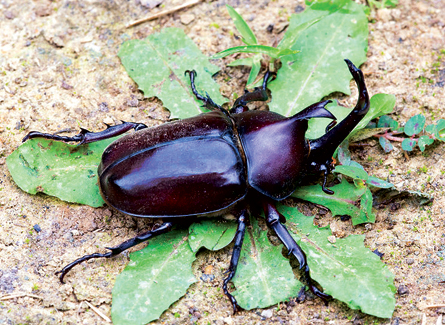Male Trypoxylus dichotomus beetles grow upswept rhino-style horns with forked tips that they use in struggles to flip rivals off trees where females feed. “Imagine a beetle flying around with a pitchfork on the front of its head,” said Erin McCullough of the University of Montana.

Cumbersome as the horn looks, though, McCullough and her colleagues are having trouble documenting much inconvenience to the beetle, she reported January 5 at the annual meeting of the Society for Integrative and Comparative Biology.
“It’s surprising,” said evolutionary biologist Christopher J. Clark of Yale University’s Peabody Museum, who heard the presentation. “It just feels like there should be a large cost.”
Even though rhinoceros beetles sport (proportionately) some of the largest male headgear among animals, the horns are hollow, and that of T. dichotomus typically weighs only about 2 percent of its body mass, McCullough said.
Even the weird shape doesn’t seem to matter that much in flight performance. Males fly about as fast as the females, which aren’t encumbered by horns.
Neither sex zooms, McCullough acknowledged. By chasing wild beetles around Taiwan at all hours of the night with a police-style radar gun, she found that the beetles chug along at 1 to 4 meters per second, topping out at about the pace of a person walking.
Males do have bigger flight muscles than females, but not so much that the extra brawn appears to physiologically compensate for the horns. Also, males don’t seem to be skimping on physiological defenses against parasites to put resources into horns, McCullough said: Males don’t have noticeably more parasites than females do.
Horns on beetles have become a classic example of a structure that arose through evolutionary pressures to win mates. These traits may be sexy ornaments for attracting favor with the opposite sex or weapons for thumping rivals. What has intrigued biologists is that these structures don’t have to be any good for promoting survival of the fittest, and in some cases have turned out to be costly to survival.
Sometimes, as with McCullough’s examination of the rhino beetles, researchers have trouble finding some cost for such structures. Clark’s tests on the long tail of a hummingbird found minimal effect on flying except during rare bursts of high speed.
Perhaps some of these sex-related structures really don’t inconvenience an animal much, McCullough speculated. That relative freedom could help explain why such so many extravagant forms of beetle horns have evolved.






